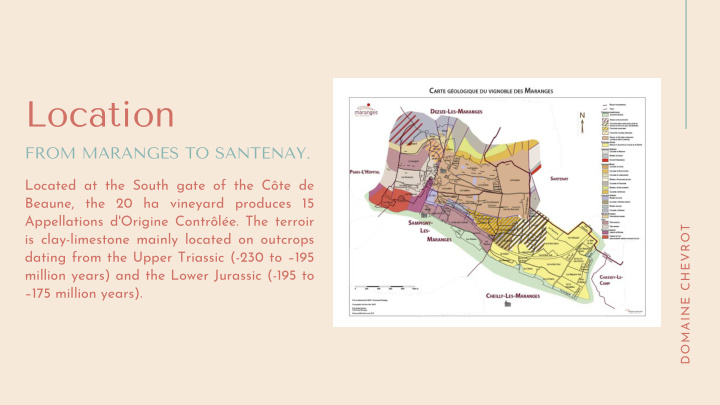



Location FROM MARANGES TO SANTENAY. Located at the South gate of the Côte de Beaune, the 20 ha vineyard produces 15 Appellations d'Origine Contrôlée. The terroir DOMAINE CHEVROT is clay-limestone mainly located on outcrops dating from the Upper Triassic (-230 to –195 million years) and the Lower Jurassic (-195 to –175 million years).
Wine from Domaine Chevrot PINOT NOIR GRAPE FOR REDS, ALIGOTÉ AND CHARD ONNAY GRAPES FOR WHITES DOMAINE CHEVROT Our Burgundies are classified Appellations of Origin Controlled regional and municipal. Exposure, diversity of terroirs, mastery of yields and winegrower's know-how will exalt your taste sensations.
Pablo and Vincent CHEVROT Both holders of a diploma in oenology, have managed the domain for more than 10 years. A family estate since 1830, generations of Chevrot have followed one another. The new generation embodied by Pablo and Vincent began certification in Organic Agriculture in 2008 . DOMAINE CHEVROT
Our Domaine VAULTED CELLARS DATING FROM 1798 The CHEVROT et FILS Estate is built around a bicentennial building with exceptional vaulted cellars where the wines are stored and aged in oak barrels (20% renewed each year). Since then, DOMAINE CHEVROT the Estate has acquired a fully thermo-regulated vat room and cellar.
OUR COMMITMENT: respect for terroirs and nature “We seek to produce wines faithful to their terroir , translating through their tastes all the qualities of the environment in which the Vines grow (Geology, pedology, ecosystem, hydrology, altitude, slope, exposure). Organic is the basis of this search for balance. To banish all the synthetic inputs which disturb our vines and cellars DOMAINE CHEVROT at all levels seemed essential to us, but we seek to go even further. We place the environment at the center of our concerns because we are convinced that a rich and healthy ecosystem is the guarantor of a healthy grape , with a complex and deep taste, balanced for the most natural winemaking possible. "
Do without herbicides and plow on horse In 2006, we decided to dispense with herbicides and work the soil.Plowing is a difficult discipline with variable geometry. To successfully master the grass, it is essential to anticipate the work as much as possible, to work in good conditions and above all to have the right tools to adapt to the DOMAINE CHEVROT vintage.For 2 years now, we have started plowing on horseback . We work 5 ha this way. We are very satisfied with the results: in addition to limiting soil compaction, the work carried out is precise and efficient. We want to quickly acquire a second horse to double the area plowed by the horse within 3 to 4 years.
A WINNING STRATEGY We seek to interest employees on a daily basis in their work. This is why we attach great importance to their training, in particular on the physiology of the vine, so that everyone can adopt good practices which make it possible to fight preventively against vineyard diseases. For us, this is a win-win strategy: improving well- being at work while improving the general condition of our plots. Thus, all the employees who prune the vine have been trained in Guyot-Poussard pruning. This size, DOMAINE CHEVROT more respectful of sap flows, limits the development of wood diseases such as ESCA. Employees who work in the vineyards during spring work have also been trained in respecting sap flows, especially during disbudding (removal of non-fruiting branches). This facilitates the next pruning and creates a microclimate unfavorable to diseases such as mildew or powdery mildew, by limiting the accumulation of vegetation.
Introducing green fertilizers to gain autonomy INCREASE THE FERTILITY OF A SOIL Sowing green manure consists of cultivating plants between our rows of vines and burying them in order to increase the fertility of a soil, not to harvest them. This also makes it possible to unpack and restructure the soils thanks to the root systems of the selected species, and to limit the erosion of the plots in winter. We generally associate grasses (oats, rye, etc.) for the soil structure, legumes (lentils, clovers, etc.) that fix nitrogen from DOMAINE CHEVROT the atmosphere, and crucifers (mustard, etc.) for the other mineral elements or to decompact. ATELIER PAYSAN The difficulty was to adapt a conventional seed drill to the rows of narrow vines that we have in Burgundy. We worked collectively with other winegrowers and the Atelier Paysan to design and manufacture a seed drill for narrow vines.We are very satisfied with the first results. This technique allows us to gain autonomy over fertilization and improve the overall functioning of our soils. "
Recommend
More recommend